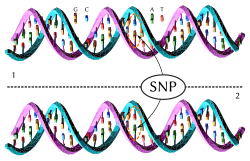Haplotype
A haplotype is a term in genetics. It is short for haploid genotype. A haplotype is a collection of specific alleles (particular DNA sequences) in a cluster of tightly-linked genes on a chromosome. A cluster is usually inherited together.[1] Put simply, haplotype is a closely-knit group of genes which a child inherits from one parent.[2]
A second meaning of the term haplotype is a set of single-nucleotide polymorphisms (SNPs) usually found together on a single chromatid (of a chromosome pair). So, finding a few alleles of a haplotype sequence identifies all other sites in its region. Such information is very valuable for investigating the genetics of common diseases.[3][4]
Comparing haplotypes of two or more people shows the degree of genetic relationship between their respective lines. It is done in genetic genealogy projects.[5]
Haplotype Media
References
- ↑ Kimball's Biology Pages Archived 2015-02-13 at the Wayback Machine (Creative Commons Attribution 3.0)
- ↑ SciTable: haplotype / haplotypes [1]
- ↑ The International HapMap Consortium (2003). "The International HapMap Project" (PDF). Nature. 426 (6968): 789–796. Bibcode:2003Natur.426..789G. doi:10.1038/nature02168. hdl:2027.42/62838. PMID 14685227. S2CID 4387110.
- ↑ The International HapMap Consortium (2005). "A haplotype map of the human genome" (PDF). Nature. 437 (7063): 1299–1320. Bibcode:2005Natur.437.1299T. doi:10.1038/nature04226. PMC 1880871. PMID 16255080.
- ↑ Haplotype versus haplogroup — the difference between haplogroup & haplotype explained.
